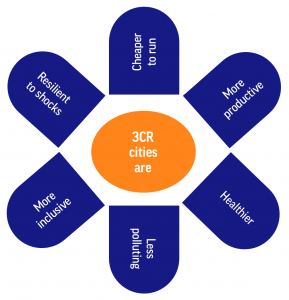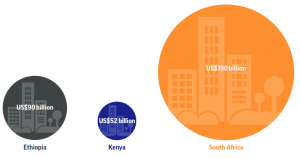
Recommendations to unlock investment for Africa’s transition to a green and resilient future.
African cities face immense challenges – and opportunities – to develop new infrastructure, buildings, and transport systems in ways that their people can prosper and with adequate resilience to the threats posed by climate change. Of the many possible routes for urbanisation, new research by the Coalition for Urban Transitions suggests the greening of cities could offer long term security and substantial economic growth for the continent.
Cities across Africa are growing faster than anywhere else in the world. Their urban populations are expected to more than double over the next 40 years. They are struggling to respond to escalating housing and infrastructure demands with the urgency required to deliver basic quality of life for their residents – over 60% are living in slums with inadequate protection for their health and employment, or the safety net of climate security.
Climate change poses a dangerous threat to African cities. Despite contributing less than 2% to global greenhouse emissions, 79 of the fastest growing African cities, including capitals and major continental hubs, are at extreme risk from climate change. They face major challenges around rising sea levels, extreme weather events and increasing temperatures – challenges that are compounded by mass urban migration.
Greening cities is a huge opportunity to address Africa’s urban and climate challenges. Analysis from three major African countries, Ethiopia, Kenya and South Africa, shows that it would unlock hundreds of US$billions in benefits and create 400,000 additional jobs by 2050.

The six benefits of compact, connected, clean and resilient (3CR) cities in Africa
Investing in Africa’s cities offers a unique chance to turn the climate crisis into an opportunity by supporting the development of a new urban economy while locking in resilience against future risks. Overcoming Africa’s urban challenges will require a balancing act to address economic growth and development alongside urgent action on climate change.
The new report demonstrates how the climate and urban challenges could be addressed in tandem, through a model of compact urban growth, connected infrastructure, clean technologies and climate resilient planning – and yield attractive returns.
In addition to the hundreds of US$billions in total benefits across major cities in Ethiopia, Kenya and South Africa, the further investment in low-carbon measures will attract hundreds of thousands of jobs, cheaper living costs and energy savings. Economic analysis commissioned for the report shows that across the 35 major cities in the three countries, delivering more compact, clean, and connected development would require incremental investment of $280 billion but produce a return of more than four times that with total benefits worth $1.1 trillion by 2050, equivalent to $330 billion in today’s terms (Net Present Value).
Greening cities in this way will help contribute to Africa’s achievement of the Sustainable Development Goals and Agenda 2063 targets for prosperity. The approach will produce cities that are more inclusive and resilient to shocks, as well as being cheaper to run, more productive, healthier and less polluting.

Expected returns on investment in compact, clean and connected city interventions after payback (i.e. NPV) to 2050
Across the 35 major cities in Ethiopia, Kenya and South Africa, delivering more compact, clean, and connected development would require incremental investment of $280 billion but produce a return of more than four times that with total benefits worth $1.1 trillion by 2050, equivalent to $330 billion in today’s terms (Net Present Value).
But scaling up the transformation across the continent will not be easy. Cities across Africa are constrained by their ability to raise capital and will be held back without access to the required investment. They need better support at national level to address budgetary constraints, high debt levels, unstable interest rates and poor creditworthiness. Many cities lack the regulatory assistance and robust revenue collection systems required to effectively plan and implement projects.
There is a vital opportunity for national and sub-national decision-makers, civil society leaders and the private sector to coordinate to support and finance low-carbon inclusive cities. Without their leadership, African cities risk that sprawling urbanisation and unplanned growth continues as the dominant picture. Together, these stakeholders can deliver tailored, replicable solutions which work for their residents.
Cities need tailored, endogenous solutions which work for their residents.
Success in mobilising the required level of investment across Africa’s diverse city landscape will require strong leadership. It will depend on the ability of national governments to set favourable market conditions to attract private sector capital for sustainable infrastructure programmes through supportive policies, regulations, pricing signals and information flows.
To assist the flow of investment into cities, it is recommended that national governments:
Mobilising finance at scale will necessitate that the regulatory and financial frameworks and policies are reformed rapidly to unlock investment in cities. In Sierra Leone’s capital, Freetown, property tax revenue has grown more than fivefold following a reform of property taxation policies to capture land value. Almost twice as many properties are now paying tax thanks to the easy to administer system which is less open to corruption and abuse.
There are many ways to drive the necessary investment for compact, connected and clean urban development but public finances alone will not be enough. The required spending is significant when compared to the forecasted spending to deliver national climate targets. Cities will therefore need to use the public funds available to attract additional private investment for the low-carbon transition.
The new report identifies six financial instruments available to cities to deploy in line with their circumstances and investment needs. All have shown through pilots to be effective, scalable and contribute positively to sustainable urban development. They represent examples of emerging energy and digital innovations, pathways to green financing, and the contexts in which private investors are ready to contribute to the sustainable vision under the right conditions.
Insurance pools are a promising finance instrument designed to build resilience to climate impacts and prepare cities for the stronger storms, extreme heat and longer droughts caused by climate change.
In the Philippines, the Asian Development Bank and national government have partnered to develop and pilot a subsidised city disaster insurance scheme to provide rapid access to finances following natural disasters. In return for a fee, the policy offers cities fast pay-outs to repair infrastructure damage after extreme weather events, earthquakes or volcanic eruptions, related to the magnitude of the event, not the damage caused.
National governments are often further along in their consideration of urban climate needs and in the development of appropriate solutions. Insurance pools offer a means for cities to benefit from the authority and expertise within national governments to mobilise adaptation and resilience financing.
The use of subscription-based pricing models is common in the digital world, where they offer a powerful solution to services with high upfront or development costs. But we are now seeing an emergence of new applications of pay-per-service business models for equipment industries, such as efficient cooling systems and lighting.
With cooling demand set to dramatically rise with increasing global temperatures, ‘Cooling as a Service’ has the potential to drive the deployment of clean cooling at scale across African cities. By charging on a pay-per-unit basis, the service eliminates the capital outlay and incentivises careful usage. This results in potential savings for customers over the lifetime of the equipment. Pilots across Nigeria, South Africa, India and Singapore have been designed for cooling services across schools, hospitals and government buildings and could be adapted to cater for other sectors, like transport.
Pay as you Save (PAYS) instruments are novel investment partnerships based on leasing agreements between city authorities and utility providers or other public agencies. The utility provides the upfront capital for the infrastructure project and recovers its costs via a monthly service charge.
In a PAYS for Clean Transport scheme, the utility purchases batteries and charging equipment for electric buses and pays for their servicing in return for a tariff. This allows them to recover costs over time, increasingly at a lower rate than the diesel’s equivalent lifetime cost. The scheme makes use of the utility provider’s ability to attract more favourable financing terms than the city authority.
In South America, PAYS schemes have demonstrated their potential to accelerate the decarbonization of public transport and improve local air quality.
Public-private partnerships (PPPs) are a widely used mechanism for securing vital additional investment across many sectors. They enable cities to get private sector technical expertise, financing support and access to the management capacity required to deliver critical urban infrastructure.
One example of a public-private partnership comes from the Indian city of Nagpur, when the city took over responsibility for providing water after the state government devolved authority after the millennium. The city formed a subsidiary company to take over water supply contracts through a partnership with private companies Veolia and Vishwaraj. The joint city-led partnership deal with private operators and the national government generated the required finances and technical assistance to fund and operate the water supply infrastructure.
Currently, partnerships of this kind are largely limited to a small number of countries, led by South Africa and Nigeria, as widespread adoption is limited by restrictive government authority in many African countries.
PPP investment in Sub-Saharan Africa has grown rapidly in recent decades, increasing from $40 million in 1990 to $175 billion in 2017. It represents a huge opportunity to overcome the lack of technical capacity and insufficient service revenues at city-level.
Green Bonds are innovative financial products used to raise investment for projects that benefit the environment, by earmarking proceeds for use on green projects.
The Breathe Better Bond, currently in development by International Finance Corporation, is a finance solution to fund sustainable infrastructure projects that improve urban air quality and reduce greenhouse gas emissions. Projects include rapid transit bus systems, solar rooftop generation and electric bus conversions. The bond is issued by local governments and offered with technical assistance to build capacity for best-practice implementation within the city.
Green bonds have the potential to mobilise significant investment for climate-friendly urban infrastructure projects, with city dwellers set to gain from better air quality, or other positive outcomes, as a result. Johannesburg has used green bonds to raise $143 million since 2014 to fund cleaner buses throughout the city.
Community climate funds offer an opportunity to channel money from international and national sources into planning and action at a local level. The devolved funds allow the public to take part in identifying and planning city developments from a guaranteed annual budget.
The most successful example comes from Kenya, where the County Climate Change Fund was pioneered to increase climate investment in projects that were identified and prioritised locally. The model earmarks 1% of counties’ development budgets to be spent on climate projects. Kenya’s County Climate Funds made more than 100 public good investments across five pilot counties by 2020, ranging from water infrastructure to livestock healthcare.
The instruments above are key approaches available to city leaders looking to catalyse financial innovations to unlock climate investment. But implementation won’t be easy. It will require proper planning to assess the right tool for the right task and city leaders to make use of technical assistance where possible. It is recommended that local governments embrace private sector investments where city financial or jurisdictional flexibility is limited.
Although the road to unlock green investment across Africa is challenging, leaders should grasp the opportunity to boost national economies’ resilience to a wide range of economic, health and environmental shocks by getting urban development right. Africa’s future will depend on the success of its cities.
VIEW THE FULL REPORT
Financing Africa’s Urban Opportunity

